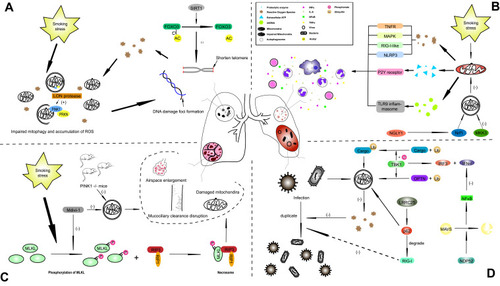Figures & data
Figure 1 The underlying mechanism of mitophagy in influencing COPD with different phenotypes. (A) The stimulus of smoking-induced stress induces excessive generation of ROS, injuries to mitochondria and impaired mitophagy, and these ROS target DNA, leading to DNA damage foci formation, which causes cellular senescence and establishes a vicious cycle. (B) In the lung tissue of COPD patients, several inflammatory cells, such as macrophages, neutrophils and CD8+ T cells, and cytokines were observed, including IFNγ, IL-6, NFκB and TNFα. Insufficient mitophagy cannot eliminate damaged mitochondria efficiently, which leads to the generation of excessive ROS, ATP and proteolytic enzymes. (C) Emphysema is caused by the basic pathological changes of COPD. CS-induced necroptosis contributes to the alteration observed in emphysema, and the phosphorylation of MLKL plays a precursor role in necroptosis-related emphysema, which can be attenuated by Mdivi-1 and PINK1 knockout. (D) Infections with bacteria or viruses can also act on molecular targets of mitophagy under conditions of mitophagy dysfunction. ROS constitute a defensive mechanism for pathogens, and overstimulated mitophagy can weaken this protective effect of ROS. The innate immune system is also affected by mitophagy through many signaling pathways, such as the TBK1 pathway.

